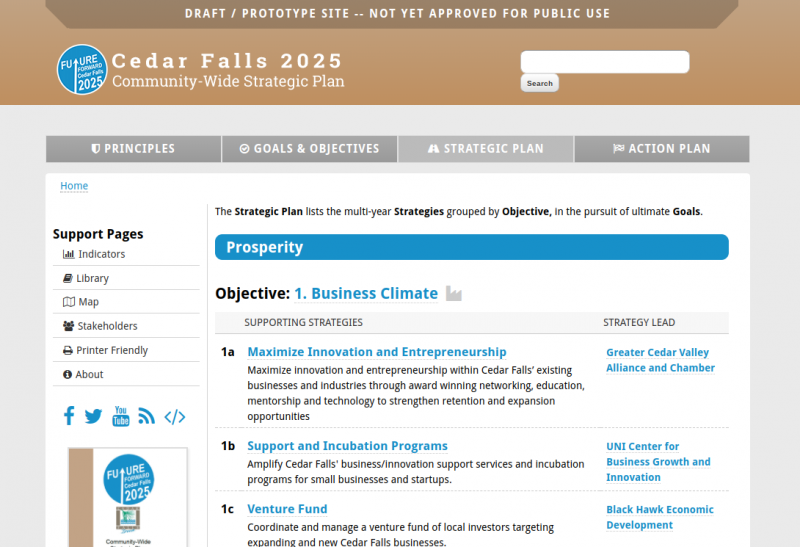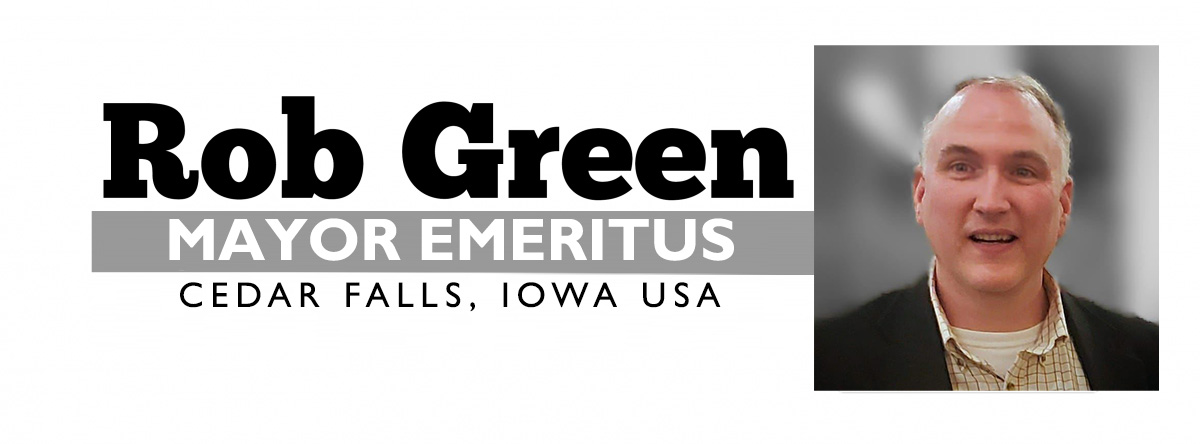
I’d like to give you a sense for where my mind’s at in terms of strategic planning (and thinking) here in Cedar Falls. I hope you’ll indulge me by reading the whole post, but I appreciate this might not be your cup of tea (and that’s OK). Alongside neighborhood development and government efficiency, the concept of strategic planning is central to my campaign….and will be a key aspect of my service to you as your City Council (At Large) Rep.
My Background in Strategic Planning
As an entrepreneur and serial ‘do-er’, I love the process of strategic planning and implementation. For more than twenty years, I’ve been connected to this discipline - first through the Coast Guard and the Naval War College, then running my own company, and now as a strategic planning facilitator for the community and UNI. I’ve put a lot of hours into understanding why strategic planning works for some organizations, and why it fails for others. In the last twenty years, I’ve gained a lot of insights that I believe can benefit Cedar Falls (and I’m still learning….so I don’t pretend to be a mountain-top guru).
Strategic planning gets a bad rap. Often it’s because an organization will invest significant time and energy into the work, print it up in a glossy folio, and then fail to follow through (i.e. implementation). Or, the plan is so generalized that no specific actions are present, and so it’s more like a listing of feel-good sentiments. That’s not strategic planning. A good strategic plan is designed for implementation, describes metrics for measuring success, and includes accountability those charged with carrying out the plan. In the strategic planning world, we seek goals, objectives, and strategies that are SMART -- Specific, Measurable, Attainable, Relevant, and Time-Bound.
This leads us to the Community-Wide Strategic Plan...
I’ve been impressed with effort, enthusiasm, and coordination displayed by the many contributors to the 2025 plan. My concern, though, is with how implementation is tracked and communicated. Here's how I'd like to improve the process:
-
Appoint an Implementation Coordinator. This should be someone outside of UNI’s Institute for Decision Making (IDM), which facilitated the Strategic Plan’s development. IDM should be retained as an implementation facilitator to help coach the stakeholders in completing their parts of the plan, but should not be responsible for the ultimate success or failure of our efforts. This needs to be owned by the community itself.
-
Seek Mutually Beneficial Strategic Plan development and Implementation Strategies with other Cedar Valley Communities. We should be sharing best practices with Waterloo, Hudson, La Porte City, Evansdale, and Janesville; we have much to learn from each other in terms of what actions can best promote our strategies, and what tools we can use to measure our strategies’ effectiveness. Our shared competence in ‘doing’ strategic planning will be a benefit to the entire region -- indeed, a rising tide does lift all boats.
-
Shrink the Strategic Plan’s Timeframe to Four Years. Our current strategic planning efforts are overly ambitious; strategic plans typically last four to five years, because strategies must be revisited to ensure they’re still relevant for meeting the overarching goals and objectives. That’s why we’re completely redoing the plan every four years anyway, and it’s inefficient. Our current plan ought to be retitled the Community Wide Strategic Plan 2016-2019...and then in 2019 build a Four Year Plan for 2020-2023, and so on. The overall mission, vision, goals and objectives can remain intact….they should still be valid (or largely so) for another six years. In 2023, we’d perform another Environmental Scan (SWOT, surveys, etc) and use that for 2024-2031. There’s simply no need to create Goals and Objectives every four years; they should be built to be applicable for eight years, unless the environment changes so drastically that a whole new cycle is required.
-
Formalize Accountability Mechanisms. If a stakeholder has signed on to lead a certain strategy in the Strategic Plan, we as a community should be holding them accountable for execution. Not a punitive thing (since most of the stakeholders are volunteer groups), but certainly accolades at the end the current strategic planning cycle for a job well done. If they’re having trouble carrying out their charge within the plan, we should be looking at providing leadership and management resources, to help them get up to speed. And at city council meetings & committee meetings, stakeholders should be prepared to provide an update on their progress on the Strategic Plan’s strategies and annual actions.
-
Publish Annual Action Plans. In line with item #4, the Implementation Team should assemble annual Action Plans for the Strategic Plan’s many strategies. The Action Plan for each year would list the specific actions that are being undertaken to promote the previously approved strategies.
-
Database the City’s Capital Improvement Plan (CIP). The CIP is an invaluable component for our community’s strategic planning efforts...but the Plan is currently available only as a series of Excel spreadsheets. The CIP should be migrated to a searchable online database, to help ‘connect the dots’ between the Community Wide Strategic Plan and proposed City initiatives.
-
Tie City Council Goal Setting to the Strategic Plan. This change seems, to me, to be the simplest and yet most difficult. Each November, the City Council and staff meet with a University of Iowa facilitator to discuss the Council’s priorities and general direction to city staff for the coming year. This year, I attended the sessions and found that the Community Wide Strategic Plan was only brought up as a bullet point for discussion as a work session. Instead, it should have been a key resource for informing the entire eight-hour discussion. I greatly appreciate the work that’s gone into getting us to this point as a city, for having our council lay out annual priorities (not an easy task). But I believe we can go a lot further, and be more efficient, by ensuring that the city’s priorities line up with what we’ve already signed on for through the Community-Wide Strategic Plan.
-
Convert the Community-Wide Strategic Plan to a Searchable, Cross-Linked Website. The Community-Wide Strategic Plan is a terrific tool for broadcasting our city’s values and aspirations. But currently, it’s simply a static PDF document, when it should be a living, real-time database of resources and information. Stakeholders come and go; new allies come online and should be added to the plan. as As an implementer of the plan, it's critical to be able to view the status of the plan as we move forward each year. Especially if the annual Actions are linked online to Capital Improvement Projects (#6) above.
-
Adopt Open Data Practices Whenever Possible. At the core of strategic plan implementation is assessment. And assessment requires data. I’m using an online service called MySidewalk to visualize city data like population changes, housing data, and economic development. This is possible because the data is available publicly in open data formats. Whenever possible, city data (like police calls for service, fire / rescue calls, applications for rental permits, etc.) should be available in easily findable and re-usable formats...not just as PDF reports on the city’s website. It shouldn’t take a special request to get this kind of information either...if it doesn’t contain protected personal information, it should be available for re-use, at no charge. This approach will allow plan implementers to craft metrics which can be routinely measured and monitored.
Though this post, I hope you can get a sense for my love of proper, effective, and practical strategic planning. It shouldn’t be an intimidating process, left only to people with fancy titles to carry out. We can all live strategically, and I see huge value in making the process as transparent and understandable as possible in our community. With wise planning and exemplary leadership, we can build the Cedar Falls -- and Cedar Valley -- we want to leave as a legacy for our children and their children.
As your City Council (At Large) rep, effective strategic planning -- and implementation of the current Community-Wide Strategic Plan -- will be at the heart of my four-year term. I hope to earn your vote December 5th.
